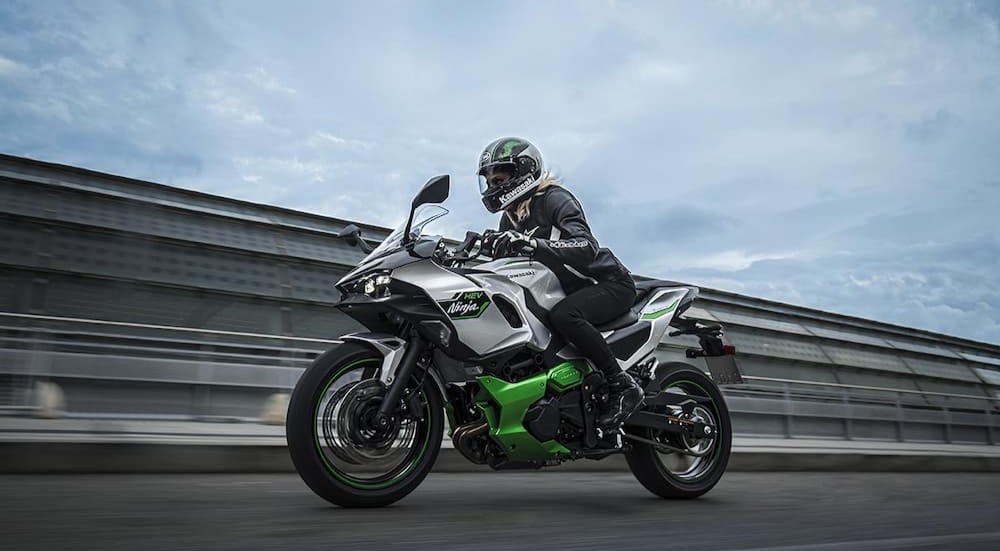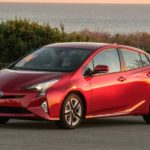Electric motorcycles are nothing new, with the first prototype models hitting the streets as far back as 1919. While they’ve never overtaken traditional gas-powered models, they have become their own in recent years. Major brands like Kawasaki, Ducati, BMW, Triumph, and Harley-Davidson’s new Livewire offshoot are making steady inroads alongside ambitious startups like Zero, Energica, and Arc. There’s just one thing: they seem to have skipped a step.
In the four-wheeled realm, it was early hybrids like the Toyota Prius that set the stage for today’s EV success. On the other hand, the motorcycle industry seems to have jumped straight from gas-powered to electric models, bypassing hybrids in a bid to create the motorcycle of the future. Was this some sort of oversight, or a calculated move by some experienced industry vets? A better question is: Do hybrid motorcycles make sense?
We’ll soon find out because hybrid motorcycles might not be as far off as some riders think. Hybrid scooters have been around for a few years, but Kawasaki was the first to take the plunge on a full-size bike. Team Green put the industry on notice at the 2022 Milan Motorcycle Show when it announced plans for the first-of-its-kind Ninja 7 Hybrid with a targeted launch date of 2024. Kawasaki has already established itself as a leader in the push towards electrification, with a commitment to move towards a completely electric lineup by 2035. The brand’s short-term goals are even more ambitious, with Kawasaki setting a goal of introducing ten hybrid or electric models by 2025.
With Kawasaki leading the way, it’s only a matter of time before hybrid motorcycles arrive at your local dealership. Integrating new, hybrid, and electric vehicles is good news for consumers and the planet alike, but despite Kawasaki’s enthusiasm, some riders might be reluctant to embrace the hybrid approach. Join us as we explore the current state of the hybrid motorcycle segment, weigh some pros and cons, and see if hybrid models really have a place in the motorcycle market.
What Is a Hybrid Motorcycle?
Before we wade into the debate over hybrid motorcycles, let’s take a moment to examine the technology in closer detail. This isn’t as tricky as it might sound, as hybrid motorcycles are similar to hybrid cars, trucks, and SUVs when it comes to their technical specs. Like hybrid four-wheel vehicles, hybrid motorcycles are powered by both a gas-burning internal combustion engine and an electric motor. Since we’ve yet to see any actual working models hit the market, we can only speculate about how the forthcoming generation of hybrid motorcycles might work, but generally speaking, there are two ways these two power sources can work together to push a bike down the road.
In a motorcycle using a parallel hybrid design, the gas engine and electric motor could both be used to power the rear wheel. The engine and electric motor could either switch off power-generating duties or work together to give the bike a little extra oomph. Rifling through Kawasaki’s recently unveiled patents around hybrid technology gives us a peek into how this approach could play out. The brand’s patent paperwork suggests that a hybrid Kawasaki might use the electric motor and its instant torque to boost the motorcycle off the starting line, with the gas engine kicking in to help it reach higher speeds. When the gas engine maxes out, another spurt of electric assist could help to unlock a little more speed for a short boost.
Then there’s the series hybrid approach. In this design, the electric motor would handle 100 percent of the work when it comes to powering the rear wheel, with the gas engine acting like a generator to recharge the battery. A series hybrid motorcycle probably wouldn’t enable the hair-raising boost you’d find on one with a parallel hybrid design, but it would probably be a lot lighter thanks to a smaller gas engine. Only time will tell which design Kawasaki prefers, but we do know they’re keeping all their options open thanks to a patent filing that details a four-way drive system with pure-gas, pure-electric, hybrid, and battery regeneration modes.
Honda’s patent filings point towards favoring a design using two three-phase electric motors. With one motor dedicated to producing power, the other could regenerate power to keep the battery charged, improving efficiency and allowing the bike to get away with packing a smaller, lighter battery pack. No matter what design makes it to market, expect regenerative braking to play a big part in any hybrid motorcycle. This technology essentially allows the electric motor to kick into reverse, converting the mechanical energy produced from the bike’s forward momentum into an electrical current that can be used to top off the battery.
Pros
Anxiety around charging is often cited as one of the major roadblocks to widespread EV adoption. Finding a charging station and killing time in the middle of a ride is a surefire way to frustrate any motorcycle owner. That’s not really an issue with a hybrid model. Assuming the forthcoming hybrid motorcycles follow in the footsteps of other hybrid vehicles, they’ll be able to gas up just like your typical internal combustion model. Running low on battery power could limit some electrically assisted functions like boost, but at least you won’t find yourself stranded in the middle of nowhere. This best-of-both-worlds approach is a big part of why hybrids have become so popular in the U.S. market, where a longstanding reliance on convenient fill-ups has left drivers with little patience for extending charging.
Motorcycles are already pretty efficient, but switching to a hybrid model could still greatly impact your monthly fuel bill. Hybrid motorcycles might not only be cheaper from a fueling perspective but also less expensive to maintain and repair, given the smaller size of their gas engines. Of course, one must also consider the environmental benefits. Again, it’s not like motorcycles are some of the prime polluters on the road, but every pound of carbon emissions makes a difference when you’re trying to do your part for the planet.
Cons
We’ll start with the main hurdle when it comes to any new and emerging technology: price. While prices are sure to go down over time as the hybrid motorcycle segment advances, riders are sure to pay a premium. You might also encounter some difficulties when it comes to repairs, as there aren’t going to be a lot of mechanics who are well-versed in this new technology. It’s all part of being an early adopter, but some riders might see it as a small price to pay for being ahead of the curve.
Gas-powered motorcycles are known for the ear-splitting noise they can produce as they tear down the road, but hybrid models could actually have the opposite problem. These bikes could be virtually silent when running in electric-only mode, as existing fully-electric models have shown. While this might go a long way in creating a relaxed, peaceful ride, it could also impact safety. Drivers and pedestrians are already notorious for ignoring motorcycles as they shift lanes and make turns, and the lack of noise could further exacerbate this issue.
When you stop and think about it, motorcycles are really a marvel of modern engineering. The fact that engineers manage to fit so many complex components into such a small package is a considerable feat, but hybrid motorcycles present an added challenge. In large part, it comes down to a matter of real estate. Space is at a premium, batteries are heavy, and packing an electric motor, battery, and all the associated parts along with a gas-powered engine is no small task. This will probably become less of an issue as the technology matures, but for now, expect hybrid motorcycles to be a little bulkier and heavier than many of the gas-powered models they’re based on.
Do Hybrid Motorcycles Make Sense?
Ultimately, there’s no right or wrong answer to this question. It really all comes down to what you’re looking for in your next bike. If you’re the type of rider who prioritizes efficiency, wants to do your part for the environment, and is more prone to short jaunts around town than long road trips, a hybrid motorcycle could be the perfect choice. If, on the other hand, you’re all about maximizing power and performance, it’s still hard to beat a gas-powered bike. The hybrid approach does hold some unique performance-related potential, like the boost feature we mentioned earlier, but it’ll probably be a while before hybrid bikes can close the gap on their gas-powered forerunners.
Efficiency benefits aside, hybrid motorcycles aren’t exactly as much of a game-changer as hybrid cars, trucks, and SUVs. Gas-powered motorcycles are already one of the most efficient means of personal transportation. With an average fuel economy of around 50 MPG, they boast more than twice the fuel economy of the average four-wheeled vehicle. Hybrid motorcycles are sure to beat that number. Some of the current all-electric models have a miles-per-gallon equivalent (MPGe) as high as 300. But pure fuel economy is rarely a rider’s first consideration when choosing a new bike.
There’s one metric that hybrid bikes need to focus on if they’re going to overtake their gas- and electric-powered rivals: performance. Motorcycles are all about excitement, and while riders are willing to make some sacrifices in terms of raw power, a successful hybrid motorcycle will still have to deliver that white-knuckle, wind-in-your-hair feeling that’s brought the segment so much success.
Only time will tell how the hybrid motorcycle segment will unfold, but there already seems to be considerable buy-in from some of the industry’s major players. If Kawasaki’s forthcoming Ninja 7 Hybrid succeeds, expect to see hybrid models flooding the market in a few short years. One might think that the presence of so many existing all-electric models might decrease the demand for hybrid alternatives, but trends in alternative fuel vehicles have become notoriously difficult to predict. Take GM, for example. While it’s not wavering from its commitment to transition to an all-electric lineup by 2035, the auto giant recently announced it will introduce a handful of new hybrid models to help ease the transition and boost short-term sales. The early adopters have already embraced EVs, and the rest of us are sure to get there as gas-powered models become exceedingly rare. In the meantime, hybrids seem to be filling a very important gap in the market. We’ll see if this will apply to motorcycles, as well.






